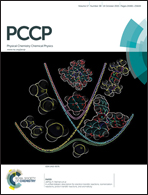Carbon and proton Overhauser DNP from MD simulations and ab initio calculations: TEMPOL in acetone†
Abstract
A computational analysis of the Overhauser effect is reported for the proton, methyl carbon, and carbonyl carbon nuclei of liquid acetone doped with the nitroxide radical TEMPOL. A practical methodology for calculating the dynamic nuclear polarization (DNP) coupling factors by accounting for both dipole–dipole and Fermi-contact interactions is presented. The contribution to the dipolar spectral density function of nuclear spins that are not too far from TEMPOL is computed through classical molecular dynamics (MD) simulations, whereas the contribution of distant spins is included analytically. Fermi contacts are obtained by subjecting a few molecules from every MD snapshot to ab initio quantum mechanical calculations. Scalar interaction is found to be an essential part of the 13C Overhauser DNP. While mostly detrimental to the carbonyl carbon of acetone it is predicted to result in large enhancements of the methyl carbon signal at magnetic fields of 9 T and beyond. In contrast, scalar coupling is shown to be negligible for the protons of acetone. The additional influence of proton polarization on the carbon DNP (three-spin effect) is also analyzed computationally. Its effect, however, is concluded to be practically insignificant for liquid acetone.


 Please wait while we load your content...
Please wait while we load your content...